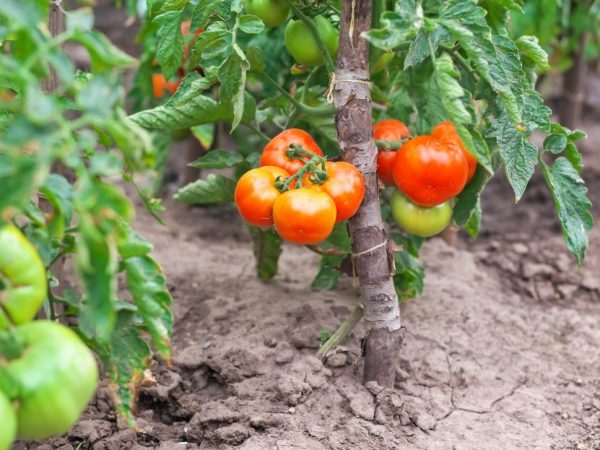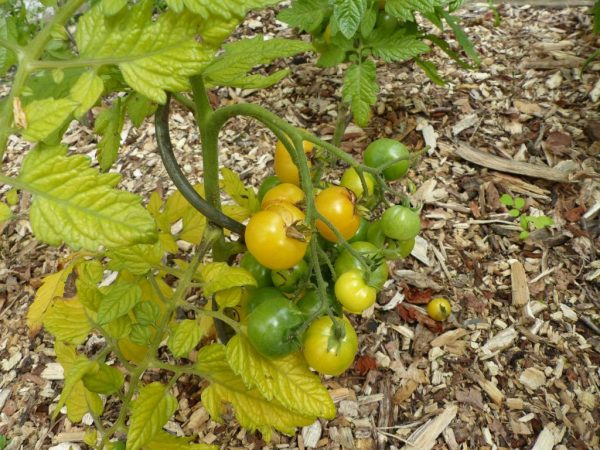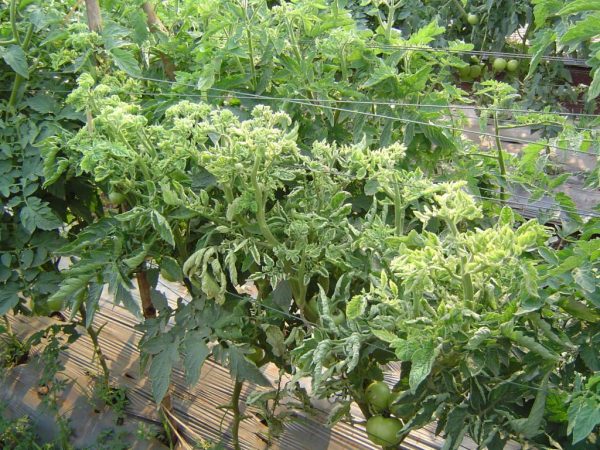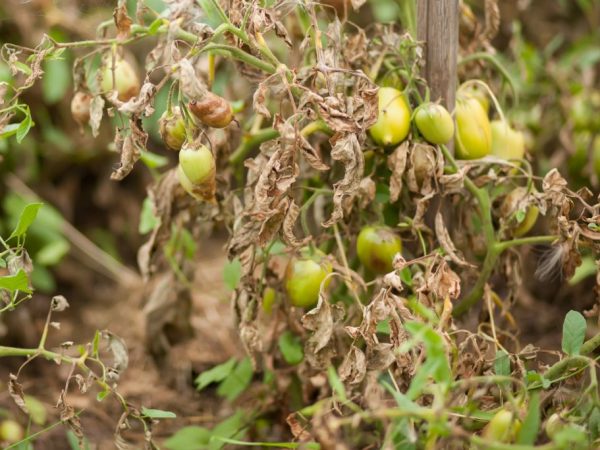Most common tomato problems
Tomatoes are susceptible to a variety of diseases. To harvest good yields of this vegetable crop, you need to understand tomato diseases and know how to treat each disease. Consider what problems with tomatoes are most common and how to deal with them.
- Leaves dry
- Lack of moisture
- Harmful insects
- Diseases
- Lack of micronutrients
- Leaves curl
- Lack or excess of moisture
- Air temperature
- Excess nitrogen
- Lack of micronutrients
- Stepping
- Pests
- Poorly formed ovary
- Temperature violation
- Violation of air humidity
- Lack of pollination
- Lack of sunlight
- Pests
- The fruits are cracking
- Improper care
- Top dressing
- Holes in the fruit
- Leaves and fruits turn blue
- Prevention of tomato diseases

Most common tomato problems
Leaves dry
Premature drying of leaves is one of the most common problems. This can be triggered by several factors. Let's consider each reason for the drying out of the leaves of the plant separately and talk about how to cope with the problem that has arisen.
Lack of moisture
Diseases are not always the cause of leaf drying. Sometimes the leaves dry out due to unscrupulous care of the vegetable crop.
Often, the leaves of a vegetable crop begin to dry out with insufficient moisture. How many times you need to water the bushes, no one will say: it depends on the climate of the region and weather conditions. After the plants have emerged, they are watered daily. After an incident of 1.5-2 weeks, grown plants do not need so much moisture - they are watered as needed.
If water is supplied irregularly on the site, it is advisable to mulch the beds with tomatoes so that the moisture remains as long as possible. It is also useful to make supplies of water. Today, it is easy to find on sale plastic barrels of various sizes, designed for installation in personal plots. They are equipped with taps at the bottom, so after their installation, you can even water the area.
Greenhouse owners who water their plants on a daily basis also face this problem. If greenhouses overheat, fungal diseases develop 2 times faster. In addition, overheating negatively affects not only the condition of the leaves, but also the development of the plant.
Some growers grow tomatoes upside down in greenhouses. With this growing method, tomatoes should be watered more often than with traditional upside-down growing.
Tatiana Orlova (Candidate of Agricultural Sciences):
Tomatoes are grown on high racks (not in the ground) with artificial soil. At the same time, tall tomatoes are not tied to the trellis, but hang down freely. There is no need to tie plants and use ladders or stepladders to remove fruits from the tops.
Harmful insects
If the leaves not only dry up, but also turn brown, the plant has been struck by the harmful insect thrips. It is miniature in size and hides under the leaves of tomatoes or in the middle of flowers.Bushes damaged by thrips do not grow well, and drying of the leaves leads to wilting of the branches. If you do not take any measures, the bush will die. Methods for controlling thrips involve the use of insecticides or folk remedies prepared at home based on a soap solution. Experts recommend giving preference to purchased drugs, since folk remedies are not always effective. In addition, if the recipe is violated during the preparation of the product, the plant can be harmed.
To prevent the appearance of thrips, which, moreover, carry viruses of some diseases, it is necessary to remove weeds in a timely manner, clean agricultural implements and attract beetles to the site, for which thrips and other small parasites are food.
Tatiana Orlova (Candidate of Agricultural Sciences):
The use of chemical insecticides with a long waiting period (up to 20 days) is allowed if the tomato fruits are still green and they will ripen no earlier than after 3 weeks.
Diseases
Diseases of tomatoes can be the cause of leaf drying. This symptom is accompanied by the following diseases:
- late blight;
- fusarium wilting;
- brown spot.
Late blight
With late blight, the leaves first turn yellow, and then dry out and fall off. The most common cause of this disease is high air humidity. If the moisture level can be controlled when growing in greenhouses, then when growing plants in open ground, this is not possible.
Tatiana Orlova (Candidate of Agricultural Sciences):
The cause of this disease is the defeat of the spores of the fungus, the causative agent of this disease. And it is promoted not so much by high air humidity as by sharp fluctuations in day and night temperatures, causing condensation and moisture loss in the form of dew on the leaves. Such weather conditions - high temperatures during the day and cool nights usually happen in August. This time is the most dangerous for the development of late blight. This disease begins with the appearance of brown spots on the lower leaves. Within a few days, the affected leaves dry out and fall off and the disease covers the entire plant.
To avoid the appearance of late blight, preventive treatment of tomatoes with appropriate preparations should be carried out. If the summer is rainy, the number of preventive treatments should be increased. From folk remedies for processing plants, you can use a solution of copper sulfate and wood ash.
The best preparation of copper-containing is Bordeaux mixture (1% solution). It contains lime, which adheres well to leaves and is not washed off by rains.
Fusarium wilting

The plant may die without treatment
Fusarium wilting affects grown bushes. This is a fungal disease that, if left untreated, leads to the death of plants. If during late blight both the upper and lower leaves of tomatoes dry at the same time, then with fusarium wilting, the leaves at the bottom of the plants first dry. In this case, before drying, the leaf plates turn yellow. You can get rid of this ailment with the help of special drugs. To prevent the disease, prophylactic treatment is carried out.
Tatiana Orlova (Candidate of Agricultural Sciences):
The causative agent of this disease is a soil pathogenic fungus. After cleaning the garden in the fall, before digging, spill it with a solution of Fitosporin, Glyokladin or simply potassium permanganate.
Brown spot
Brown spot is also fungal in nature, but before the leaf plates dry out, brown spots appear in this case. Damaged leaf plates should be destroyed, and the bush should be treated with a fungicide.
To minimize the risk of any disease, quality planting material should be used. It is best to give preference to varieties of hybrid origin, which have immunity to many tomato diseases.
Lack of micronutrients
Tomato leaves dry even with a lack of trace elements. To determine which trace element the plant lacks, you need to take a closer look at the bushes. If the leaf plates not only turn yellow, but also curl, the plant lacks copper. Even with a lack of copper, the leaves become brittle. With a lack of boron, in parallel with the drying of the leaves, dark spots appear on the fruits. With a lack of calcium, a yellow edging first appears at the edges of the leaf plates, then the leaves dry out. Also, a lack of calcium is accompanied by a slowdown in the growth of bushes.
This problem is solved by the introduction of appropriate fertilizers, but when feeding tomato bushes, it is important not to overdo it. An excess of nutrients affects the development of tomatoes no less negatively than their lack.
Tatiana Orlova (Candidate of Agricultural Sciences):
In case of an acute deficiency of a microelement, it is better to resort to foliar dressing (by leaves). The fact is that this deficiency often arises not due to the real absence of any elements in the soil, but in the inability of the plant to absorb them by the roots. For example, calcium deficiency occurs if the heat is above 30 degrees. Tomato roots cannot absorb calcium at high temperatures. On acidic soils, some trace elements turn into insoluble complexes and also cannot be assimilated.
Leaves curl
When rolling the leaves, you need to act very quickly. Any delay will cost a significant portion of the harvest.
Lack or excess of moisture
Leaf curling occurs with a slight lack of moisture. If you do not take action, the leaf plates will begin to dry out. An excess of moisture also leads to the fact that the leaf plates curl up. Every gardener should know that with an excess of moisture, the leaf plates twist outward, and with a lack of moisture, inward.
If there is an excess of moisture, you should build a roof for the tomato beds. It is best to make it from thick film. If you use a material that does not allow sunlight to pass through, the growth of plants will slow down, which will negatively affect their productivity.
Air temperature
Sometimes the cause of leaf curling is an excessively high air temperature (more than 35 ° C). After sunset, the leaf plates are straightened. In a well-equipped greenhouse, adjusting the air temperature is easy. If we are talking about growing tomatoes in the open field or in a greenhouse where there is no way to adjust the temperature, you can save the plants by mulching. Organic matter is used as mulch.
You can save plants from the heat by shading the planting. At home, the bushes are shaded with the help of improvised means. If the summer is too hot, it is advisable to plant the crop in the shade of trees.

High temperatures are harmful to plants
After the sun sets, the leaf plates of the plant are treated with a weak solution of potassium permanganate or urea. When preparing a solution with urea for 8 liters of water, 1.5 tbsp. l. urea.
Excess nitrogen
Leaf curl also appears with an excess of nitrogen. In this case, only the top leaf plates of the tomatoes are curled. In addition to rolling the leaves, the stem thickens. The sheets themselves become thick and break easily.
Tomatoes get nitrogen not only from nitrogen fertilizers. This trace element is found in large quantities in manure, chicken droppings and herbal infusions, so feeding tomatoes must be done carefully.
When the above symptoms appear, it is advisable to refuse feeding with any fertilizers containing nitrogen. It is necessary to exclude even formulations containing this trace element in an insignificant amount. After the appearance of fruits, only fertilizers containing potassium and phosphorus are used as dressings.
Lack of micronutrients
Curlyness is also characteristic of plants that lack potassium or phosphorus. If the tomatoes lack phosphorus, the leaf plates are folded down. The color of the leaves also changes. They turn dark green or purple. With a lack of potassium, the leaf plates twist upward. Light spots appear on the fruits.
The problem is solved by applying the appropriate fertilizers. From organic matter, wood ash can be used.
Stepping
Sometimes the cause of leaf curling is improper pruning of the bushes. You cannot remove a large number of stepchildren in one go: this will provoke stress in the plant. To help recover, the plant is fed with a growth stimulant or a complex fertilizer is applied to the soil.
Pests
Leaf plates are often curtailed due to the activity of harmful insects. This symptom may indicate that a red spider mite, aphid or whitefly has appeared in the beds. These miniature insects live on the inside of the leaf and feed on the sap of the plant. In addition to the fact that the leaves curl, dark specks appear on them, the yellowing of the leaf plate occurs.
We use pesticides to combat pests. Folk remedies in this case are ineffective, and every day of delay leads to the death of the bush. As a preventive measure, you should inspect the leaf plates from the inside daily, even if they look healthy. It is important to do the inspection after the sheet plates have rolled up too late.
Some varieties are characterized by lowered and slightly curved leaves.
Poorly formed ovary
Tomatoes do not bloom well for many reasons. But most often the cause of this phenomenon is improper planting care.
Temperature violation
Tomato is a thermophilic culture. Accordingly, at low temperatures, you should not expect that the bushes will delight you with a large amount of ovary. Do not expect an abundance of ovary even at high temperatures. If the temperature drops below 15 ° C, the pollen is unable to ripen. Accordingly, flowers do not ovary. At temperatures above 35 ° C, tomato pollen turns into sterile. It is not possible to protect tomatoes outdoors from a drop or rise in air temperature. In the greenhouse, you can always adjust the air temperature.
Violation of air humidity

Fungal diseases develop at high humidity.
The second reason why tomatoes that bloom produce little ovary is excessively high or low humidity. With low air humidity, tomatoes lack moisture. The bushes wither and the flowers fall. With increased air humidity, not only diseases provoked by the fungus develop, but pollen also remains in the anthers, clumping together. Accordingly, no pollination occurs.
Lack of pollination
Insects should pollinate the plants, but if it's cold outside, insects may not fly to the backyard. Accordingly, pollination of tomatoes will not occur. You can pollinate the plants yourself at home using an ordinary brush. Also, it will not be superfluous to attract insects to the backyard that pollinate vegetable and fruit crops. To do this, you need to plant more flowers.
Tatiana Orlova (Candidate of Agricultural Sciences):
The vast majority of tomatoes are self-pollinated crops. They do not require insect pollination. Moreover, the pollination process often takes place inside the flower bud, i.e. the flower opens up already pollinated.
Lack of sunlight
Lack of sunlight leads to the fall of flowers. When planting seedlings, the norms regarding planting density should be observed. Tall bushes are planted at a distance of 50-70 cm from each other. Low-growing varieties can be planted a little thicker. With a lack of light, the plants stretch excessively upward.
Pests
Another reason why tomatoes grow slowly and bloom little, and the flowers that appear fall off, are nematodes. These worms damage the root system. It is not possible to save the affected plants. Plant protection involves pest control of the soil and its timely digging. Another preventive measure is the correct planting of seedlings. Before planting the plant, the soil is treated with a weak solution of potassium permanganate. Not only leaves are subject to processing, but also the root system.
Tatiana Orlova (Candidate of Agricultural Sciences):
The well-known flower plants of marigolds frighten off the nematode. You can use them as a casing for garden plants and in the form of green manure, i.e. at the end of the season, remove them from the flower bed, grind and dig up in the beds where nematodes have been seen.
The fruits are cracking
Sometimes during the ripening of tomatoes, the fruits crack. Cracked tomatoes fade quickly and are not as juicy as those that do not burst during ripening.
Improper care
Tomatoes do not tolerate sudden changes in air temperature or humidity. When growing a vegetable crop in open ground, summer residents rarely encounter this problem, although in this case we are talking not only about air humidity, but also about soil moisture. It is important not to overflow the soil during the ripening period of tomatoes. To control the moisture level, you should from time to time dig a hole 8-10 cm deep and look at the condition of the soil. If it does not stick together into a lump, the moisture content of the soil is normal.
Top dressing
In general, tomatoes whose fruits are already turning red do not need frequent watering or feeding. If, nevertheless, it is decided to apply fertilizers, concentrates undiluted in water should not be used. The vegetable culture must be fed with preparations of low concentration.
Holes in the fruit
Sometimes holes can be seen on the fruits of the plant. At first glance, it may seem that the fruits are beaten by hail. If there was no hail, the plant was beaten by something else: the caterpillars of the cotton bollworm. Methods of dealing with this pest involve not only the use of pesticides, but also planting flowers with a strong odor, which scares away harmful insects. It is best to plant calendula tomatoes nearby. You can also use an infusion, in the preparation of which garlic arrows are used.
Leaves and fruits turn blue
Gardeners rarely encounter this problem. If the leaves or stems turn blue, it means that the temperature was too low when growing the seedlings, or the plants do not have enough phosphorus. Do not rush to feed the bushes with fertilizers containing phosphorus. If the room temperature is low, the root system will not absorb this trace element. First of all, you need to take care that the growing tomatoes receive the heat they need.
Prevention of tomato diseases
All diseases of tomatoes, regardless of whether they are bacterial or fungal, lead to the death of bushes, so it is very important to follow several rules when growing tomatoes. First of all, you need to change the planting site of the vegetable crop at least 1 time in 2-3 years. You should also timely fertilize the plants with fertilizers and spud the beds.
Of course, it is necessary to treat plants with drugs for the most common tomato diseases, which include powdery mildew, bacterial cancer, streak, scab, bacteriosis, mosaic, macrosporiosis. Experts do not recommend making drugs for diseases on their own. After harvesting, the tops, which accumulate spores of fungi and bacteria, should be burned or taken out of the garden.
Tatiana Orlova (Candidate of Agricultural Sciences):
For viral diseases of tomato - mosaic, streak, bronze, viral jaundice, there are currently no remedies. Carriers of these diseases are aphids and leafhoppers.Therefore, all measures to combat viral diseases are aimed at combating their vectors.



